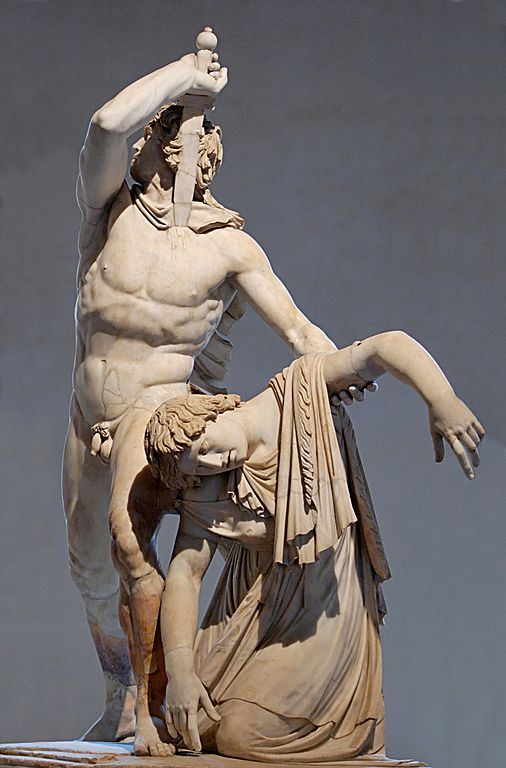The Hellenistic Style of Sculpture Is Best Described as
O The so-called genre sculpture of the Hellenistic period shows old people or hard working persons of the lowest social strata peasants and fishermen topics that were never before rendered in this medium and were known only from vase painting. The subject of this piece titled Lacoön is described in Virgils Aeneid.

Hellenistic Art Alchetron The Free Social Encyclopedia
First to sculpt nude female form in ancient Greek life-sized statue.

. The Hellenistic period in both history and in art refers to the era of the conquests of Alexander the Great and the subsequent spreading of Greek culture throughout the major cities and nations of Southern Europe the Mediterranean and Near East. TheHellenistic periodwas an era in Ancient Greece that lasted from 323 BCE to 31 CE. What phrase best describes the achievement of.
Though religious and moral values still had an impact on their art secular views made its way into the sculptures. They were more interested in. Jewelry became more elaborate.
Hellenistic period Styles of Hellenistic sculpture were determined by places and schools rather than by great names. Literally wrote the book on Hellenistic sculptural canon. Emotions pain and suffering were emphasized with the realistic view of art.
During this period sculptors pursued and perfectednaturalisman artistic interest that Greek artists ha. 21 December 2016. View The style of artists working in the Hellenistic times represents which type of styledocx from ART 1401 at University of the People.
The Hellenistic period begins right around 323 BC with the death of Alexander the Great. The Greeks under Alexander were able to break the center of the Persian line and with boldness turn the battle into a rout. The style of artists working in the Hellenistic times.
Pergamene sculpture is exemplified by the great reliefs from the altar of Zeus now in Berlin and copies of dedicatory statues showing defeated Gauls. It w as found during the Renaissance in the remains of the Palace of Roman emperor Titus and is believed to date to the first century AD. For example the stylecontent of Archaic existed in the Hellenistic period as Hellenistic neo-Archaic.
From late Archaic to Classical to late Hellenistic the development of Greek sculpture always built on and included past process. Attic sculptor in the 4th century. Renders the subject as a god Portrays the subject with idealized youthfulness Depicts the.
323 BC 27 BC. A semihuman follower of Dionysos Lacoon and his Sons. Krahmer the Late Hellenistic style contrasted with the former styles by the open form and the centrifugal structure of its figures exemplified by the so-called Venus de Milo Chapter 16 Fig.
Persia takes control of Mesopotamia. Possibly was more than one person. Sculptures became more dramatic almost theatrical.
1617 it cannot be denied that in Late Hellenism figures of diverse themes and types often have a broken rhythm. Page Contents hide Photo Gallery Description and Significance Where to See Hellenistic Sculpture. Which of the following best describes this sculpture.
Cambyses fails in his attempt to capture Kush. It was more emotional and realistic than classical Greek sculpture. 476 Although the open form is not confined to this period see supra nn.
The style is Hellenistic Baroque -- similar to the style of the Altar of Zeus at Pergamon. Hellenistic sculpture takes the naturalism of the bodys form and expression to level of hyper-realism where the expression of the sculptures face and body elicit an emotional response. Persia is defeated by Greece.
Many copies exist of his famous work. The emergence of classicizing statuary in the fourth century BCE and its uses and transformations in the changing and complex world of the. Which statement best describes the style of Hellenistic sculpture.
More admiration was given to the female beauty as well. D Laocoön and his Sons. The art movement of this time period is mostly expressed through sculpture.
Darius the Great extends the Persian empire into Europe and to India. Art during this time started to move away from the typical classical ideals with artists of the time infusing their works with new stylistic choices. A number of the best-known works of Greek sculpture belong to this period including Laocoön and His Sons Venus de.
Hellenistic art is the art of the Hellenistic period generally taken to begin with the death of Alexander the Great in 323 BC and end with the conquest of the Greek world by the Romans a process well underway by 146 BCE when the Greek mainland was taken and essentially ending in 30 BCE with the conquest of Ptolemaic Egypt following the Battle of Actium. Hellenistic Sculpture The subtle implications of greatness and humility of the high Classical era see the Charioteer of Delphi are replaced with bold expressions of energy and power during the moments of tension as evident in the Boy Jockey. While Archaic Classical sculptors are awake and alert Hellenistic sculptors explored sleep entrance into fantasy world of dreamantithesis of Classical ideals of rationality and discipline Satyr.
Preview Table of contents is listed at the end of the review Hellenistic and Roman Ideal Sculpture. A the good life consists of moderate pleasure and the avoidance of pain. Virgil 70-19 BC was a Roman poet.
Which statement best describes the view of the Epicurean philosophers of the Hellenistic world. Which work best illustrates the emotional intensity and drama of the Hellenistic style in sculpture. Cyrus the Great conquers the Medes and the Lydians.
Drama and pathos are new factors in Hellenistic sculpture. The Allure of the Classical by Rachel Kousser is a short monograph tackling a phenomenon spanning several centuries.

An Introduction To Hellenistic Art In 12 Works

Hellenistic Period Art And Visual Culture Prehistory To Renaissance

No comments for "The Hellenistic Style of Sculpture Is Best Described as"
Post a Comment